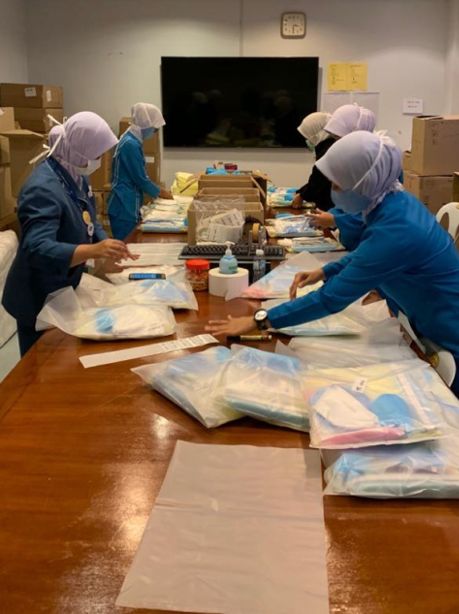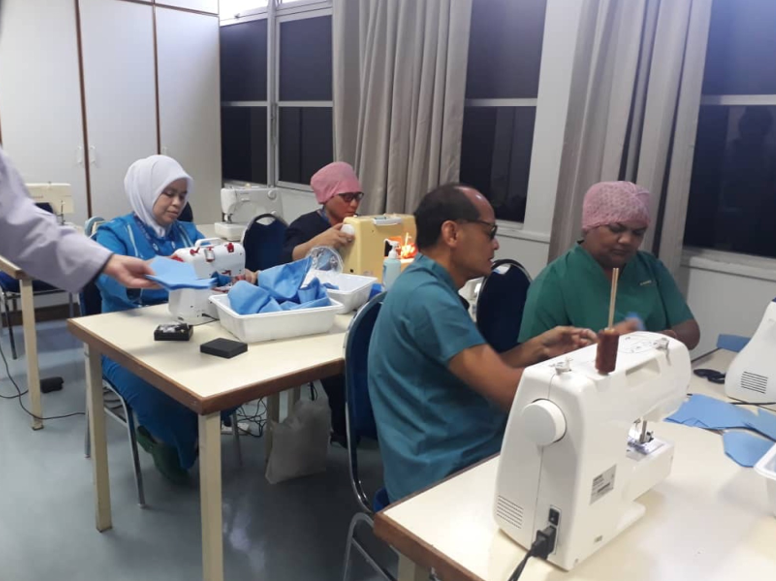Published on July 30, 2020
Malaysia is among the countries whose well-coordinated responses to the COVID-19 pandemic helped slow the virus and reduce the number of deaths. The country has reported just under 9,000 confirmed COVID-19 cases, with 124 deaths. Cardiac surgeon Dr. Sivakumar Sivalingam (Dr. Siva) from our Center of Excellence Institut Jantung Negara (IJN) in Kuala Lumpur describes how his center was affected by the pandemic.

PPE packaging at Institut Jantung Negara, Kuala Lumpur
Can you provide a brief overview of the current situation with COVID-19 in Kuala Lumpur and in Malaysia?
The first case of COVID-19 infection was reported on the 25th of January from a traveler to China. There was a sudden surge in the number of reported COVID-19 cases in early March. At that time, Malaysia recorded the largest cumulative number of confirmed cases in Southeast Asia. A medical response to the outbreak was established by the Ministry of Health, overseen by the Director General of Health Dr. Noor Hisham Abdullah (Children’s HeartLink is fortunate to work with him on strengthening the health system in Malaysia). The Ministry of Health hospitals, or state hospitals, were categorized as COVID-19 hospitals focused on managing confirmed and suspected cases. Some hospitals managed COVID-19 patients along with other patients. IJN is a private hospital that fell under the third category of non-COVID-19 hospitals and therefore we did not manage any active COVID-19 patients.
The current situation in Malaysia is in the recovery phase from the Movement Control Order (This order was issued by the Malaysian government in March to implement a lockdown and later, a partial lockdown in response to the COVID-19 pandemic. In June the country entered the recovery phase, after the order was lifted). There are currently only isolated small clusters of positive COVID-19 cases that arise on a daily basis. However, the Malaysian government is taking adequate remedial measures, anticipating a second wave of the infection.
How has your hospital and cardiac program been impacted due to the pandemic? (For example, patient volume, financial losses, staff morale, PPE shortage)
As I said, we did not have any patients with already confirmed cases admitted to IJN. However, we had two patients who were admitted with cardiac conditions and were subsequently tested positive for COVID-19. The first step was to set up a COVID-19 internal data center to track all patients and health care professionals within IJN on possible exposure to the infection. Adequate measures were taken to create special isolation rooms for patients with confirmed or suspected COVID-19. Negative pressure rooms were prepared for ventilated patients. Recently admitted patients also stayed in designated isolation wards and were transferred to normal wards after testing negative for COVID-19. There was only one patient with congenital heart disease who was tested positive for COVID-19. This was a case of Heterotaxy syndrome that presented with hemoptysis and pneumonia to a state hospital. This person was transferred to a COVID-19 center before admission at IJN for treatment.
The number of interventions and surgical procedures dropped to 50 percent of the usual workload for a period of 6 weeks. We were only involved in treating urgent and emergency cases from other hospitals throughout the country. We had arranged for a special ambulance service to bring the patients here from other district and state hospitals. We also had to airlift some emergency patients through mercy flight with the help of the armed forces. The hospital incurred some financial losses during this time.
During the peak of the pandemic, 10 members of the IJN staff tested positive for COVID-19, which caused a lot of stress among the staff at large. Fortunately, all 10 recovered from the infection. To improve staff morale during this time, the COVID-19 staff support group was established. The objectives of the group were to ensure staff welfare, their emotional and financial support, and regular communication on the management plans. All staff under quarantine were provided with accommodations by the hospital. Everyone on staff was provided with free masks and hand sanitizers and underwent a compulsory test for COVID-19.

PPE production at IJN
Because of an increased demand for PPE, the hospital faced an acute shortage of PPE, face masks and hand sanitizers due to air transportation restrictions. Hence IJN had to start producing face masks, face shields, head covers, gowns and hand sanitizers to cope with the increasing demand of these essentials.
What challenges have your patients with heart disease and their families had accessing the care they need?
Patients who scheduled follow-up visits were not able to come from other regions due to lockdown. IJN made arrangements to provide home delivery for medications. The hospital had to send a letter to the patient to obtain special permission from the police to come to IJN to pick up the medications.
Patients who needed acute care and were not able to make it to IJN were referred to the regional hospitals for further care. Due to the closure of the interstate borders, many interventions were delayed.
We do not have the facility to provide telemedicine consultations with patients and their caregivers in remote areas. Hence it was difficult to provide consultations to certain high-risk patients who need close monitoring of their cardiac condition. IJN is now working on setting up a telemedicine service to get in touch with patients and families for direct consultation.
The biggest challenge came from the patients and families themselves. There was a stigma about visiting hospitals to seek treatment for fear of contracting COVID-19. Even high-risk patients who needed regular check-ups did not want to visit hospitals. Fortunately, when those patients came recently for follow-ups, we did not see any acute deterioration in their cardiac conditions.
Do you have any positive experiences to share about patients who had heart surgery during the pandemic?
Despite the travel restrictions, we had a few patients who received immediate medical care, which was made possible by the tireless work of all health care professionals.
A 2-month-old baby boy was admitted to a state hospital with hypoplastic aortic arch with borderline left ventricle and pulmonary hypertension. The child was ventilated and transferred to IJN, and immediate surgery was performed on the child, since discharged and doing well. The second case was a 3-month-old baby boy previously diagnosed with severe aortic stenosis who underwent a percutaneous balloon valvotomy in the neonatal period. The child was transferred urgently in a state of shock due to deteriorating left ventricular function. On admission, we noted recurrent stenosis of the aortic valve. Urgent surgical balloon valvotomy was performed, and the child was discharged and is doing well. The third case was a neonate with a diagnosis of a mixed type of total anomalous pulmonary venous drainage. The baby had to be airlifted on a mercy flight to IJN, where he underwent successful corrective surgery and was discharged.
Despite the closure of international borders, IJN was also able to continue providing urgent treatment for children with CHD from the neighboring countries. A 23-day-old neonate in Jakarta, Indonesia, was diagnosed with Tetralogy of Fallot and was severely cyanosed with frequent spalls. Thanks to the well-coordinated efforts between the members of the Little Heart Community of Indonesia, the JIN Paediatric and Congenital Heart Centre, the IJN Private Healthcare Division and the Malaysian Healthcare Travel Council, the baby was airlifted from Jakarta to Kuala Lumpur and arrived in the stable condition to IJN. The child underwent a successful right ventricular outflow tract stenting and is keeping well.
During this period we were also able to perform urgent cases such as arterial switch operation, repair of TAPVCs, pacemaker implantation, placement of shunts, and urgent corrective surgery for Tetralogy of Fallot.
